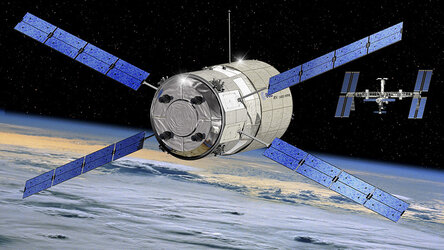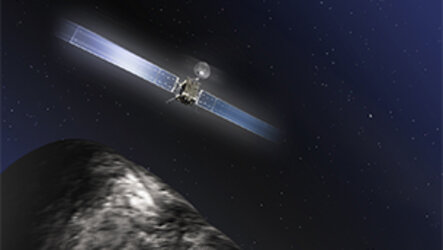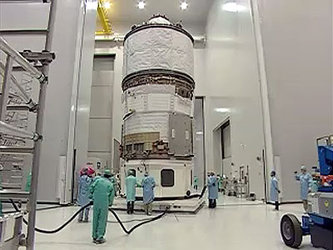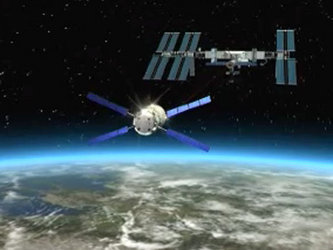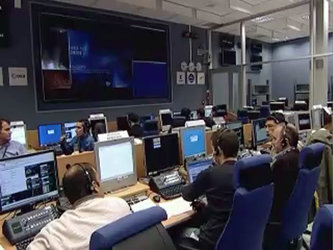Europe’s automated ship docks to the ISS
ESA PR 20-2008. ATV Jules Verne, the European Space Agency’s first resupply and reboost vehicle, has successfully performed a fully automated docking with the International Space Station (ISS).
This docking marks the beginning of Jules Verne’s main servicing mission to deliver cargo, propellant, water, oxygen and propulsion capacity to the Station, as well as ESA’s entry into the restricted club of the partners able to access the orbital facility by their own means.
The 19-ton unmanned spaceship manoeuvred from a holding position 39 km behind the 275-ton space outpost and conducted a 4-hour staged approach with several stops at reference points for checks. It autonomously computed its own position through relative GPS (comparison between data collected by GPS receivers both on the ATV and the ISS) and in close range it used videometers pointed at laser retroreflectors on the ISS to determine its distance and orientation relative to its target. Final approach was at a relative velocity of 7 cm/s and with an accuracy of less than 10 cm, while both the ATV and the ISS were orbiting at about 28000 km/h, some 340 km above the Eastern Mediterranean. ATV Jules Verne’s docking probe was captured by the docking cone at the aft end of Russia’s Zvezda module at 16:45 CEST (14:45 GMT). Docking was completed with hooks closing at 16:52 CEST (14:52 GMT).
First automated docking
This is the very first time in Europe that an automated docking is performed in due respect of the very tight safety constraints imposed by manned spaceflight operations. All the approach and docking phase was piloted by the ATV’s onboard computers under close monitoring by the teams of ESA, CNES (the French Space agency) and Astrium (the prime contractor) at the ATV Control Centre at CNES Toulouse, France, as well as the ISS crew inside the Zvezda module. In case of anomaly, both ends could trigger pre-programmed manoeuvres to hold position, retreat to the previous reference point or escape to a safe distance.
The ATV’s behaviour was also under surveillance from its own independent Monitoring & Safing Unit (MSU), which uses a separate set of sensors and computers to check that the approach manoeuvre is conducted safely. In case of major anomaly, the MSU would have been able to take over the commands and order a Collision Avoidance Manoeuvre (CAM) through dedicated avionics chains and thrusters.
As all operations went smoothly, none of these safety manoeuvres was required during this afternoon’s approach and docking.

The ATV Jules Verne was launched by an Ariane 5 from Europe’s spaceport in Kourou, French Guiana, on 9 March. Three days later, it successfully demonstrated its autonomous CAM capability and was cleared for ISS proximity operations. The spaceship then moved to a parking orbit for the duration of space shuttle Endeavour’s visit to the ISS. On March 29 and 31 it conducted two rehearsals of today’s docking, approaching at 11 m from the Station.
New delivery service
Now that it is docked, the ATV Jules Verne will become an additional module of the ISS for about four months. The astronauts will enter its pressurized cargo module and retrieve 1,150 kg of dry cargo, including food, clothes and equipment as well as two original manuscripts handwritten by Jules Verne and a XIXth century illustrated edition of his novel “From the Earth to the Moon”. In addition, they will pump 856 kg of propellant, 270 kg of drinking water and 21 kg of oxygen into Zvezda’s tanks.
The ATV can carry about three times as much payload as Russia’s Progress freighters but on this mission, most of it is actually propellant to be used by the ATV’s own propulsion system for periodical manoeuvres to increase the altitude of the ISS in order to compensate its natural decay caused by atmospheric drag. If required, the ATV will also be able to provide redundant attitude control to the ISS or even perform evasive manoeuvres to move the Station out of the way of potentially dangerous space debris. The first of ATV Jules Verne’s reboost manoeuvres is currently scheduled on 21 April.

“The ATV is so much more than a simple delivery truck, it is an intelligent and versatile spaceship which has just demonstrated its extraordinary skills,” said Daniel Sacotte, ESA’s Director for Human Spaceflight, Microgravity and Exploration. “It is the largest and most complex spacecraft ever developed in Europe and the second in size of all the vehicle’s visiting the Station, after NASA’s space shuttle. With Columbus and the ATV, we have entered the major league of the ISS.”
“The docking of the ATV is a new and spectacular step in the demonstration of European capabilities on the international scene of space exploration ”said Jean-Jacques Dordain, ESA’s Director General. “This fantastic step is in first instance the result of collective work in Europe, including ESA Member States, industry under Astrium as prime contractor, CNES and ESA staff as well as among ISS partners, in particular the USA and Russia. We shall now reap the benefits of such investments after the launch of ESA’s Columbus laboratory, first in utilizing the unique capabilities of the ISS and secondly in preparing for the exploration of the Solar System. Now that the ATV is "up and running", I am happy to announce that in the next few weeks ESA will launch a recruitment campaign to hire new European astronauts"
For further information:
ESA Media Relations Office
Communication and Knowledge Department
Tel: + 33 1 5369 7299
Fax: + 33 1 5369 7690















 Germany
Germany
 Austria
Austria
 Belgium
Belgium
 Denmark
Denmark
 Spain
Spain
 Estonia
Estonia
 Finland
Finland
 France
France
 Greece
Greece
 Hungary
Hungary
 Ireland
Ireland
 Italy
Italy
 Luxembourg
Luxembourg
 Norway
Norway
 The Netherlands
The Netherlands
 Poland
Poland
 Portugal
Portugal
 Czechia
Czechia
 Romania
Romania
 United Kingdom
United Kingdom
 Slovenia
Slovenia
 Sweden
Sweden
 Switzerland
Switzerland


























